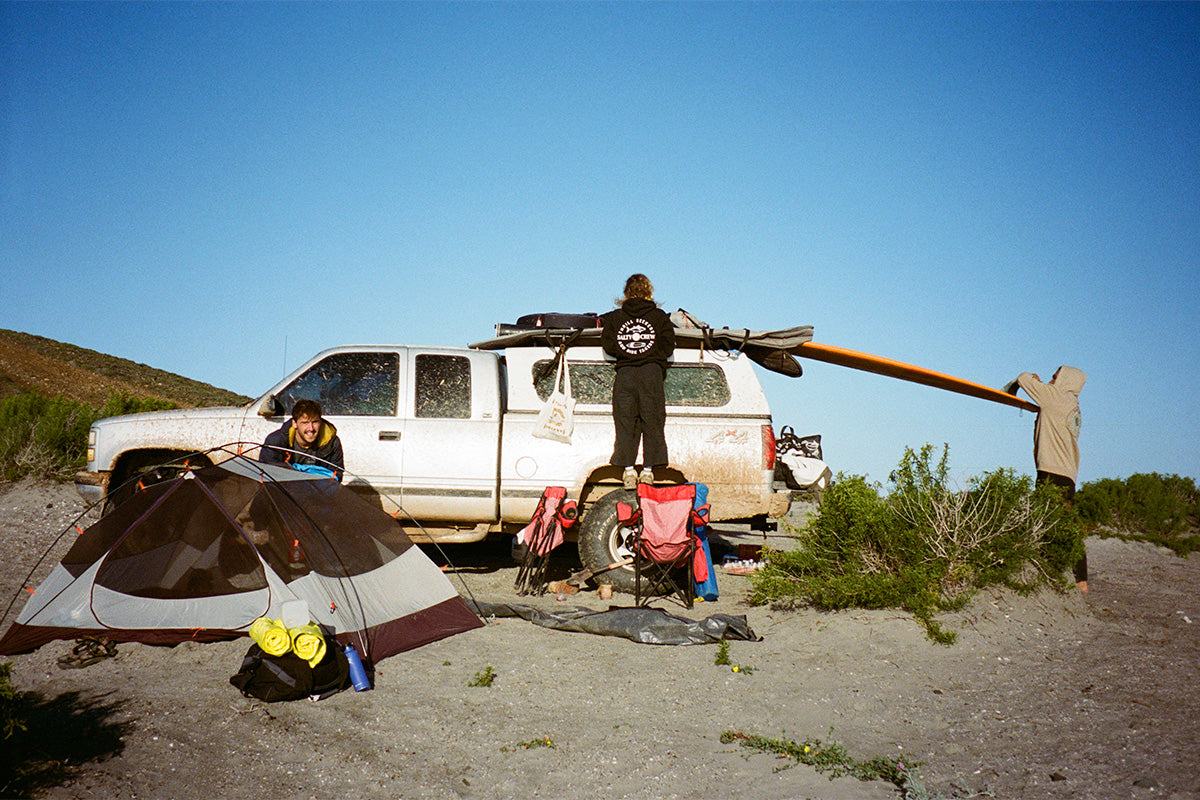Unplugged
Beth Leighfield and Bella Bunce Go Off-Grid In Mexico
Unplugging yourself from the connectivity of day-to-day life is a difficult, but often worthwhile, thing to do. Removing the distractions (particularly our phones) gives space to be present in the moment, focus on daily routines, and surf a lot. This is exactly what recent addition to the C-Skins team Beth Leighfield and photographer/filmmaker Bella Bunce and their partners intended to do when they travelled to Mexico this spring; time to surf, without the distractions. For Bella, it was also an opportunity to dive deeper into the world of filmmaking, documenting their trip as a personal creative project to further develop her craft. Beth’s partner Paul has family in northern Mexico, so this is becoming something of an annual trip for them and last year they invested in a truck they nicknamed Gerry the GMC that could handle the washboard roads of Baja and rural mainland Mexico, and that they could set up to camp out of. This year they were joined by Bella and her partner Tom, and the group planned to spend a month off-grid and unplugged in Baja before heading over to the mainland and making their way to Mexi Log Fest in La Saladita.
The result of their time camping in Baja is 'Unplugged' a seven-minute short film about “a group of friends exploring untouched nature, searching for quiet waves and freedom.”
As we welcomed Beth to the C-Skins team, we caught up with both B’s to find out more about their time in Baja. Scroll right to the end to watch Unplugged!

Beth, what was your total route from picking up your truck to the end of the four month trip?
We started with my partner’s family in the state of Sonora in Mexico. To get to Baja we did a two day drive up and into the US, across Arizona and California, before crossing back into Mexico, Baja at the Tijuana border. We then surfed our way down the Pacific coast of the Baja peninsula, took the ferry over to the mainland and then surfed down the coast of mainland Mexico ending up just north of Oaxaca. All in all I think it was over 10,000 miles travelled!

How did you prepare for that and what was your set-up – supplies, communications, surf forecasting, charging camera batteries, and how and how-often did you have to head back to civilisation to resupply?
Baja isn’t the sort of trip you can just pop over for a holiday. It involves a fairly big investment of time and money. We first went to Baja last year and it involved months of planning and research, then six weeks of finding and converting a truck into a liveable off-road wagon before our trip even began. It’s also quite hard to do the trip coming from England; you can’t buy a vehicle in Mexico unless you’re Mexican (gracias Paul). There’s a load of safety gear you need that I had never even thought of before, like tyre inflators, max tracks (getting stuck in sand is no joke), a big first aid kit, and a range of spare vehicle parts. If you break down or have a medical emergency you could quite easily be at least a five hour drive from the nearest very small village, let alone a big hospital. Communication-wise we had a small satellite device that we could send 80 character messages with. We bought this for emergencies, and also emergency surf report requests to my mum! The scariest moment last year was when my mum messaged on the Garmin saying that there was a tsunami warning. There were a few Californians camping with us and they said that you always get them. I was freaking the hell out though!
Once we had fully loaded the truck (with Bella and Tom as well) we could go nearly two weeks off-grid (depending how much beer to water ratio we drank). That was two weeks with no contact with the outside world, which was pretty blissful.

Bella, how did the film evolve – did you have particular shots or scenes in mind or was it a pure documentary that you then pieced together afterwards?
It all started with a strong passion to become a surf videographer. I needed a place without distractions to fully immerse myself in the craft, where the daily noise wouldn't hinder my camera skills while capturing my favorite thing – longboarding.
Learning how to use a video camera in late 2022, I was eager to challenge myself and create a short surf edit inspired by talented surf filmmakers like Nathan Oldfield, Thomas Campbell, Seth Hughes, and Alex Patrick. I also noticed that surf adventure stories often featured men, and I was driven to change that narrative. I wanted to celebrate longboarding and highlight women exploring the wild and unique places. That’s why the beauty of Baja’s isolation was the perfect open space to learn; there could be no diversions, I would be thrown in at the deep end to make this project without any prior knowledge.
We knew that we wanted to capture lots of surfing and then a general feel of the camp lifestyle, without giving a way any spots or making the video too “vloggy”. But truthfully the only shots that I had in mind were the end credits, where everyone involved had a task to pick their favourite looking cactus on the trip and I would film them next to it!

The film has a great variety of shots, from in-water, wide land-based surf shots and drone footage. How did you make the call on how to capture each session?
(Bella) - That was a really hard call to make every day, because naturally I always gravitate towards in-water as it’s the most satisfying when you nail it. But I underestimated how cold it would be in the sea, so sometimes that would force me out onto the land. However I didn’t have a long lens, only a 24-60mm so I had to get creative with taking wide land-based shots, without showing too much scenery for people to recognise or work out the spots we were surfing. If you give away too much information it takes away from the adventure of searching for these places yourself. We were travelling with Paul, who knew Baja and Mexico better than us, so he was really helpful in guiding us to keep certain aspects out of shot. But in all honesty the waves were very fickle when we were out there, so any time there was some good first light surf, we would film it as much as we could so then later that day we could just chill and have an evening of surfing ourselves.

Describe a typical day during your time in Baja
(Bella) - Wake up, surf, eat a Mexican style cooked breakfast, have a nap, read, do some stretching, eat lunch, go for a walk, maybe surf in the evening, cook dinner, play cards, drink beer, sleep and repeat. (All the while filming throughout the days too!)

What was your aim with documenting this trip and creating a film to share?
(Beth) - I think for us we wanted to share our trip with our friends and family in the UK. Heading off to Baja is such a far-flung idea compared to the regular Euro winter strike mission, and it takes a lot of time, effort and planning.

Beth - what kit did you take with you (surfboards and wetsuits etc - a chance for us to link to product).
It’s good to bring a quiver to Baja. More often that not it’s small, and it’s nearly always windy, meaning we had a quiver from fishes through mid lengths to a range of logs. Temperature-wise, with the wind it can get pretty nippy so my go-to was the Solace 4:3 womens chest zip steamer and I also had an Element 3:2 shorti and a Solace 1.5mm womens zipped vest for the warmer days.

















